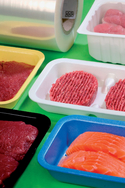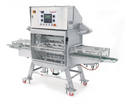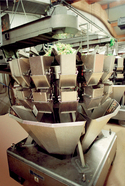Fast food off the shelf
19 February 2007To captitalise on the growth in the convenience food sector packaging companies are serving up “new and improved” recipes to differentiate product and reduce costs. Jo Hunter discovers who's in the mix
Busy lifestyles continue to fuel demand for microwaveable and other quick-to-prepare ready meals and snacks. It is a large and growing food sector and machinery manufacturers and converters across the different material mediums and pack formats recognise the opportunities to increase their share of the market.
A preponderance of plastic and paperboard in the market is being challenged, notably by aluminium and steel based packaging, which is making a bid to improve market share. The association of European steel producers APEAL and the German body Verband Metallverpackungen, VMV, representing can makers have commissioned a technical study by the German Fraunhofer Institute into metal as a suitable medium for heating food in a microwave oven. Due to be completed in May, the study's findings are expected to recommend the use of metal packaging that is specially designed for the microwave heating of food and the results will support a call for microwave oven manufacturers to adopt new consumer instructions for their appliances that will specify metal packaging that is safe to use.
Steel then is aiming to shed its old-fashioned image among food manufacturers and consumer preconceptions to become accepted as a material that answers today's needs. Arcelor Packaging, for example, has developed Créasteel to produce creative, shaped and easy to use packaging and is targeting microwave-ready prepared meal producers. Arcelor says an “excellent” deep-drawing performance makes possible innovative solutions and designs that differentiate products and are practical to use; trays adapted for microwaves are, to be fit for purpose, shallow with wide openings but they can be also given distinctive shapes.
Arcelor says test results show that food in steel containers reheats evenly in a microwave oven and in this regard compares well with plastic containers. It argues that steel packaging provides a durable support for individual portions and there is no need to transfer the food to a plate before eating. All of which underlines the suitability of steel for the heat-and-eat market.
Tray packaging generally is enjoying a good run in the ready meals market and developments in tray sealing equipment have helped make it the chosen format for a growing range of convenience products, says Steve Malone, director of machinery manufacturer Proseal. He says that as well as convenience, consumers want freshness. Fresh, chilled varieties of ready meals need to look appetising and increasingly consumers are looking for fewer additives in their prepared meals. Easy opening adds to the user-appeal of trays and for the retailer they are easy to handle and store and stack, while manufacturers gain efficiencies because a single machine can run a number of tray sizes and weights.
Malone goes on to say that, given the improved look and preservation qualities of top sealed trays through the use of MAP (modified atmosphere packaging), overwrapping is losing out in end-markets such as fish and meat. The upshot is that food manufacturers can extend production runs and enjoy reduced cost benefits.
He reports that while the UK can be considered the pioneer of ready meals and convenience foods in the European market, their popularity is becoming more marked in mainland Europe, particularly in the demand for pre-packed product. Eastern Europe, along with the Middle East and Australasia, is showing “excellent growth potential”. The scope of products ranges from large, heavy products such as whole chickens, to healthy snacks including fresh fruit pieces and ready-to-eat salads; and ever more sophisticated ready meal recipes are influencing tray designs.
The 1990s saw a steady drive towards the use of CPET for trays, but now the market is seeing a swing back to board. Arguably, it is a more natural product that lends the packaging a greener image to reinforce the “fresh” messages of the food it contains. When producers in the sandwich market wanted to make the switch, Proseal responded with a linear conveyor sandwich packing system for paperboard sandwich skillets.
Conformity with hygiene regulations will continue to give momentum and direction to tray development as legislation becomes increasingly strict - MAP technology and features such as waterproof and stainless steel construction address such issues.
The environmental debate poses a further challenge to heat-sealing technologies, and progress is being made. In conventional systems, when two different plastics are sealed together, for example polyethylene film onto a polyester tray, the materials need to be laminated first for the sealing to be effective. This makes the materials - notably the skeletal waste - non-recyclable.
Radio frequency (RF) technology is providing answers here on two fronts - prevention of food waste and packaging waste problems. In traditional heat-sealing, contamination can get into the seal to prevent the pack from being closed properly, affecting the shelf life of the product. RF works by changing the molecular structure of the materials that are being welded and causes the materials to be heated from the inside out. The same material can be used for a weld seal or a peel seal and with no water-cooling or cooling period.
“Since it can weld together different materials without the need for lamination, any skeletal waste can be 100% re-used,” says Malone. “As with any emerging technology, RF is still relatively new and further development work will take place in the coming months and years to refine the systems and bring a range of machines to the commercial market. The technology may not be right or appropriate for every application but it will have a valuable role to play alongside traditional heat-sealing systems.”
Whatever the sealing method, a window is required to see clearly into the tray, which requires a high-performance film with anti-fog properties and crystal-clear appearance. Shrink lidding films from Linpac in the Lintop Star range offer high gas barrier multilayer films for the modified atmosphere packaging of meat, poultry, fish, prepared meats and ready meals. The different versions with shrink characteristics adapted to different types of trays are made from EPS/EVOH/PE, APET/PE, PSX/EVOH/PE, and PP mono-material. They claim excellent sealing at high speeds even on contaminated surfaces and can be used on inside and outside cut lidding machines or on form-fill-seal machines.
Staple favourite snacks are moving into “convenience” packaging that in some cases incorporates sophisticated technology which can generate new lines and profit streams for established brands. For example, Heinz last year announced the development in New Zealand of a ready-prepared beans-on-toast combo product for the toaster. Meanwhile Heinz Foods South Africa has made its pot pies more convenient by cutting preparation time to five minutes using a microwaveable pot and susceptor technology from Graphic Packaging International (GPI).
“Using the previous packaging, the product required 30 to 35 minutes of baking in a conventional oven,” says Bob Babich, manager of market development for GPI.
The bowl is made using GPI's MicroRite Qwik-Crisp material, which consists of susceptor-coated polyester laminated to a paperboard base. A “special” MicroFlex Q patch - strategically placed on the inside of the outer folding carton - browns and crisps the pot pie crust on top leaving the pie-filling “moist and tender”.
The packaging “enables us to achieve a microwaveable pie with the desired texture, flavour and colour”, says George Lemon, general manager of the frozen foods division at Heinz Foods South Africa, and “we expect it to help us significantly grow the frozen convenience foods market.”
RPC Bebo Nederland recently introduced ready meal packaging to allow consumers to safely remove meals from the microwave without burning their hands. Re 228 and Re 171 Comfort are polypropylene trays with built-in notches on either side to make them easier to handle. The trays are also safe for the freezer, automatically sealable and 100% food approved, in single and multi-compartment options.
Convenience food packs are being made from biodegradable PLA (polylactic acid) by RPC Bebo UK in Bristol. They can be used for leaf salads, pasta salads, fresh fruit, snacks and delicatessen products. There are 375ml, 650ml in single and twin compartment versions, and 1500ml sizes, with a positive stacking feature so one pack sits snugly on top of another to fit more products on a shelf. These packs can also be specified in APET.
An Ishida Fresh Food Weigher installed at French ready meals manufacturer Le Magicien Vert replaced an arduous manual packing operation to raise packing speeds to 35 packs/min and now makes light work of producing own-brand fresh and frozen meals such as paella and fricasseed lamb.
Hoppers are arranged in linear tiers fed by a row of belts that carry the product from the infeed. A single operator can comfortably supervise the eight belts, adding or removing product, or swapping product from belt to belt, to maintain an even flow. The entire packing line, which previously required nine staff, now only needs four.
Product changeovers on the weigher, which handles up to 25 different recipes each day, are completed in around 15 minutes with the help of the “pit stop” installed by Ishida next to the weigher, which carries racks of clean, ready-to-switch contact parts including belts and hoppers.
Ishida also came up with solution for the German producer of microwavable Suppina single-serve soups. To fill and seal pots of soup at 30 packs/min without spilling a drop, it developed a so-called walking-beam system that operates with its QX 775 traysealer,
Empty pots arrive on a metal bar which is moved to the filling position using precise servomotor control and with the nozzles just above the pot rims. In this position, filling with the hot soup can take place without a spill or a splash onto the rims, to avoid any risk of interference with the sealing process.
The inside-cut seal option on the QX-775 gives a neat tray rim; the peel-off tab makes it easy for the consumer to open; and a paperboard sleeve provides all-important handling protection and branding surface.
Meanwhile, improved yield means greater profits for a German salad producer who installed a 14-head weigher from Ishida's R-Series. Some 50,000 bags and 36,000 trays of Gartenfrisch Jung salad products are produced daily for the retail market and 25 tonnes for the catering industry. Giveaway per pack reportedly has dropped by more than 2.5%, so for every 40 packs of salad produced, the new machine delivers one extra pack from the same amount of washed and prepared material.
Ishida has also “completely re-engineered” its QX-1100 traysealer. An output of up to 200 trays/min, Ishida believes, is a 25% improvement on current rivals and makes it “the fastest twin lane traysealer in the industry”.
To achieve such a performance, it features advanced servomotor control, an “innovative” gripper arm design and enhanced software. For quality control there is fully integrated checkweighing and gas analysis, a web cam and product recognition camera. Rejected packs are removed before sealing, to limit film wastage and allow trays to be re-used wherever possible, while inside-cut sealing gives the trays a “perfectly presented” finish.
To sum up: steel is on a mission to position itself in the convenience market; trays that offer sealed-in freshness carry ready meal producers' hopes for continual growth in sales; innovative machinery technology and pack design are squeezing bigger profits from the same amount of raw material, shopfloor and shelf space; old brands are learning new tricks to refresh the image of staple favourites and create new lines. . . . .Such is the hunger for “new and different” in the convenience sector shown by food producers, retailers and consumers that packaging companies have an open door to profitable business opportunities. These will not -alas - be served on a plate but demand ingenuity and focused investment.






